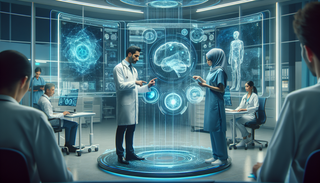
From buzzword to bedside
Five years ago, “AI in healthcare” was mostly a slide in conference keynotes. Today it is weaving itself into daily clinical workflows—often unnoticed. Algorithms flag subtle lesions on CT scans before a radiologist even opens the file. Chatbot triage systems sort tens of thousands of e-mails from patients overnight. Genomic models sift through millions of variant combinations to suggest which therapy a specific tumor is likely to resist.
Why now? Three forces converged: cloud-scale data, cheaper computing, and regulatory clarity. In 2024 the U.S. Food and Drug Administration cleared more than 500 software-as-a-medical-device (SaMD) products—double the number in 2020. Europe’s AI Act and fast-track pathways in Asia created clearer guardrails, coaxing hospitals to move experimental pilots into production.
Where AI already outperforms humans
-
Medical imaging accuracy. Large vision models trained on hundreds of millions of de-identified images now spot breast cancer up to two years earlier than human radiologists in controlled studies. At the Mayo Clinic, an algorithm reduced false positives in lung-nodule detection by 60 %, cutting unnecessary biopsies and patient anxiety.
-
Speed of interpretation. Emergency departments equipped with AI triage for head CTs cut time-to-treatment for intracranial hemorrhage from 55 minutes to 15—an eternity when every minute of bleeding kills brain tissue.
-
Pattern discovery in “omic” data. Deep-learning models that integrate genomics, proteomics and metabolomics can predict whether a chemotherapy cocktail will succeed in a specific patient with 85 % accuracy—far higher than today’s trial-and-error approach.
-
Continuous monitoring. Wearables and smart implants generate minute-by-minute streams of heart rhythm, oxygen saturation and glucose levels. Edge AI filters noise and surfaces only clinically actionable anomalies, letting one nurse remotely supervise dozens of at-risk patients instead of one.
Personalized pathways, not one-size-fits-all
Traditional evidence-based medicine treats the average patient; AI enables precision for the individual. Consider pharmacogenomics: by modeling how gene variants affect drug metabolism, an algorithm can predict the optimal warfarin dose for a 72-year-old woman within 0.1 mg—something no clinician can eyeball. In oncology, sequence-to-sequence models compare a tumor’s mutational signature against vast drug-response databases to recommend a bespoke cocktail. Early trials at Memorial Sloan Kettering show a 30 % improvement in progression-free survival when AI-guided regimens are used.
Predictive medicine is also going mainstream. A model trained on electronic health records (EHRs) of 5 million patients can forecast the likelihood of rehospitalization for heart failure with an area-under-the-curve of 0.90. Physicians receive a dashboard ranking patients by risk score, enabling proactive interventions—diet tweaks, medication adjustments, or home visits—before deterioration begins.
Black boxes, bright lines
Yet AI’s leap from research papers to real wards raises thorny questions.
• Transparency. Most deep-learning systems remain opaque. Regulators now demand “explainability layers” that show which pixels or lab values drove a decision. Tools like SHAP and saliency maps are appearing in commercial products, but clinicians still worry about liability if they overrule—or blindly trust—the machine.
• Bias baked into data. If a model is trained mostly on images of lighter-skinned patients, detection accuracy for darker skin drops. The remedy is laborious: curating diverse datasets and running subgroup performance audits as part of ongoing model surveillance.
• Integration headache. A brilliant algorithm is useless if it lives in a separate dashboard. Hospitals are investing in FHIR-native APIs and single-sign-on workflows so AI insights appear inside the EHR timeline where clinicians already live.
• Cybersecurity. An adversarial pixel perturbation can trick a melanoma detector into classifying a malignant mole as benign. Vendors now harden models with adversarial training and federated learning, but the arms race is young.
The regulatory runway widens
Regulators are shifting from one-off approvals to lifecycle oversight. 2024 guidance from the FDA establishes a “predetermined change control plan,” allowing vendors to roll out periodic model updates without resubmitting an entirely new application. The European Medicines Agency is experimenting with “regulatory sandboxes” where innovators test algorithms on real-world data under supervision, shortening time-to-market while preserving patient safety.
Reimbursement is following. In the United States, Medicare created new CPT codes that pay for AI-assisted diagnostics, turning what used to be a cost center into a revenue line for hospitals and encouraging adoption in smaller community health systems.
What happens next
-
Foundation models fine-tuned for health. General LLMs dazzled the public, but 2025 will see domain-specific models trained on multimodal medical data—images, waveforms, text and genomics—powering unified clinical copilots.
-
On-device inference. Chips purpose-built for neural networks will push inference to point-of-care ultrasound probes and even smart stethoscopes, bringing AI to rural clinics without reliable broadband.
-
Patient-facing AI. Beyond clinicians, patients will use conversational agents that translate jargon-filled lab reports into plain English and coach chronic-disease management, shrinking the knowledge gap.
-
Real-world evidence feedback loops. Continuous post-market monitoring will evolve algorithms from static products into learning systems that improve with every case—blurring the line between software release and clinical trial.
If the last decade digitized medicine, the next will intelligently digitize it. The stethoscope may remain around a doctor’s neck, but inside its bell lives code that listens, learns and spots what human ears miss. The result is not a replacement of clinicians but an amplification: faster, more accurate, and, crucially, more personal care.
Sources
- Financial Times. “AI transforms medical imaging accuracy.” https://www.ft.com/content/2fd63023-ec0a-421c-9abb-b6c8000b3b51
- News-Medical. “AI and predictive medicine: recent advances.” https://www.news-medical.net/news/20240304/AI-and-predictive-medicine-Recent-advances.aspx